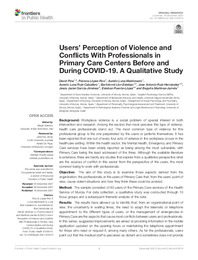Title:
Users' Perception of Violence and Conflicts With Professionals in Primary Care Centers Before and During COVID-19. A Qualitative Study |
Authors:
Pina, David 
López Ros, Paloma
Luna-Maldonado, Aurelio
Luna Ruiz-Caballero, Aurelio
Llor-Esteban, Bartolomé 
Ruiz-Hernández, José Antonio 
García-Jiménez, Jesús Javier
Puente López, Esteban 
Martínez Jarreta, María Begoña  |
Editor:
Frontiers Media |
Department:
Departamentos de la UMH::Ciencias del Comportamiento y salud |
Issue Date:
2021-12-16 |
URI:
https://hdl.handle.net/11000/34313 |
Abstract:
Background: Workplace violence is a social problem of special interest in both intervention and research. Among the sectors that most perceive this type of violence, health care professionals stand out. The most common type of violence for this professional group is the one perpetrated by the users or patients themselves. It has been reported that one out of every four acts of violence in the workplace occurs in the healthcare setting. Within the health sector, the Mental Health, Emergency and Primary Care services have been widely reported as being among the most vulnerable, with Primary Care being the least addressed of the three. Although the available literature is extensive, there are hardly any studies that explore from a qualitative perspective what are the sources of conflict in this sector from the perspective of the users, the most common being to work with professionals. Objective: The aim of this study is to examine those aspects derived from the organization, the professionals or the users of Primary Care that, from the users’ point of view, cause violent situations and how they think these could be avoided. Method: The sample consisted of 80 users of the Primary Care services of the Health Service of Murcia. For data collection, a qualitative study was conducted through 10 focus groups and a subsequent thematic analysis of the data. Results: The results have allowed us to identify that, from an organizational point of view, the uncertainty in waiting times, the need to adapt the telematic or telephone appointment to the different types of users, or the management of emergencies in Primary Care are the aspects that cause most conflicts between users and professionals. In this sense, suggested improvements are aimed at providing information in the mobile application updated on the opening hours or maintaining the telephone appointment for those who need or request it, among many others. As for the professionals, users point out that the medical staff is perceived as distant and sometimes does not provideenough information on the health status of users. Another professional group widely addressed in the focus groups was the administrative staff, being described as lacking in communication skills, assertiveness, or empathy. Users recognize the existence of a demanding/aggressive profile among users, who makes instrumental use of violence to achieve privileges over users in general. We have also identified the profile of the user who makes use of Primary Care as a way of socializing or managing conflicts of a socioemotional nature. As proposals for this thematic block, users suggest group therapies, the use of audiovisual material complementary to the information provided by professionals or community interventions in psychoeducation. Conclusion: This study allows to explore conflicts between users and professionals from the Primary Care patients’ perspective. Our results are complementary to the available evidence that has used the professional’s approach to study the phenomenon of workplace violence. The identification of sources of conflict and the assessment and contribution of users on possible ways of improvement can serve as a basis for the design of prevention and intervention plans to improve the work environment in Primary Care centers.
|
Keywords/Subjects:
violence
Primary Care
users
healthcare workers
qualitative |
Type of document:
info:eu-repo/semantics/article |
Access rights:
info:eu-repo/semantics/openAccess
Attribution-NonCommercial-NoDerivatives 4.0 Internacional |
DOI:
10.3389/fpubh.2021.810014 |
Published in:
Frontiers in Public Health. 2021 Dec 16:9:810014 |
Appears in Collections:
Artículos Ciencias del Comportamiento y Salud
|

.png)
